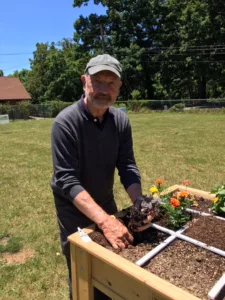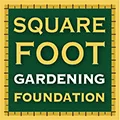Certified Instructor Hughes Roberts grew up in a small tobacco farming town in Virginia. He says, “My father had a half-acre typical row garden and, when I was a teenager, he gave me a hoe and told me to learn to love it. I never did.”

Certified Instructor Hughes Roberts
He says he did find, as he was a young adult, that he was interested in gardening and planted his own row garden.
“The work tired me out so I would walk away from it,” he says. “Years later I saw Mel’s book and watched some of his PBS show and started raised bed gardening. I had a tiller and would till the raised bed garden and that was a lot of work.”
Then, he says, he really started to pay attention to Mel’s books and Mel’s updates in the method. “I got much more oriented toward less work and better yields!” A few years ago, he found out about the CI program, and went through the program. “Once I was certified I started talking to the local library in Waynesville, NC, asking if I could present using the material that the Square Foot Gardening Foundation was providing, including Mel’s intro video and the PowerPoint presentation.”
For last 3-4 years Hughes has been speaking twice a year, once in Waynesville and once in nearby Canton. “Lots of older people who like cooler weather and don’t want to do a lot of work and weeding live here. The Square Foot Garden principles work extremely well with the culture and the demographic of the area.”
The Giving Garden
Speaking led to his work with the Giving Garden in Canton, adjacent to the library, which is a converted school building. “A cooperative extension agent started the garden on some unused space outside the library, working with the Master Gardeners, Friends of the Library group, and the library administration.” The original group built several 4’ x 4’ raised beds.
Hughes says, “When I jumped in to work with the garden I started suggesting using and teaching the Square Foot Gardening principles in the teaching garden and the classroom to help people understand that they could get nice yield at home with a small space.” He said the Master Gardeners have been great in adopting the principles and the project.
Junaluska School Garden
Another project Hughes has been involved with is the Junaluska School garden. “Marcia Tate was working with me at the Giving Garden in Canton. She was interested in reviving the Junaluska garden after the garden had gone to ruin.” (He says it had been a very active program for about 10 years but then the volunteers had aged out and the garden had fallen by the wayside.) “The school was looking at it as something to get rid of but Marcia, asked, ‘Can I use Square Foot Gardening at the Junaluska garden?’ and really got going with it. I worked with her, gave her a copy of the book, and did whatever I could to get the message to her that this method would be excellent for teaching first graders.”
Hughes credits Marcia and her volunteers for the success of the school garden. “She and some other volunteers restored that garden. I showed them how to build raised beds, how to put grids down, and how to Square Foot Garden, and they’ve used it for a couple of years with first graders very successfully.” He stresses that the success of school gardens and community gardens depends heavily upon the volunteers. “If you don’t have committed volunteers, you might as well forget it!” he says.
Tips from Hughes
We always love to ask CIs for their best SFG tips. Here are Hughes’:
• Sunlight makes a big difference in your success. He says “If you try to garden without enough sunlight you will be disappointed.”
• Lean on succession planting. Plant new crops every 10 days to two weeks so that everything isn’t ripe at once.
• Be willing to try it, make mistakes, and keep going!
